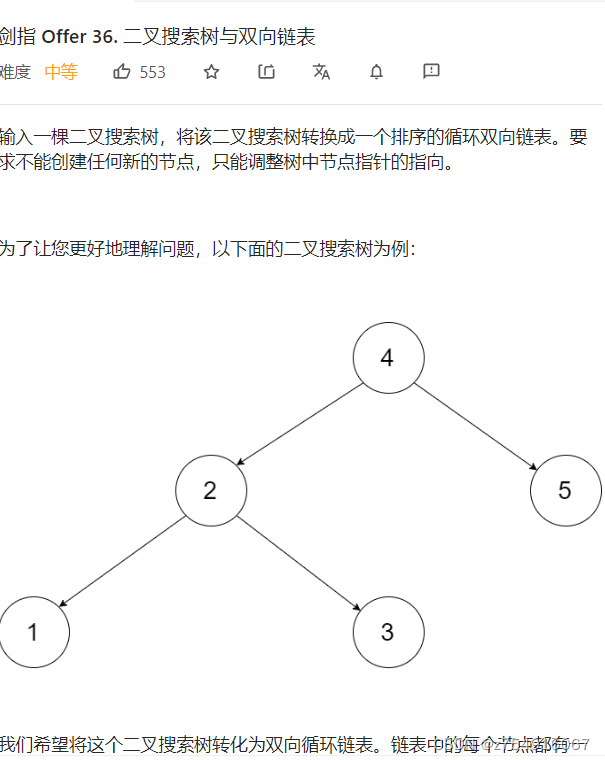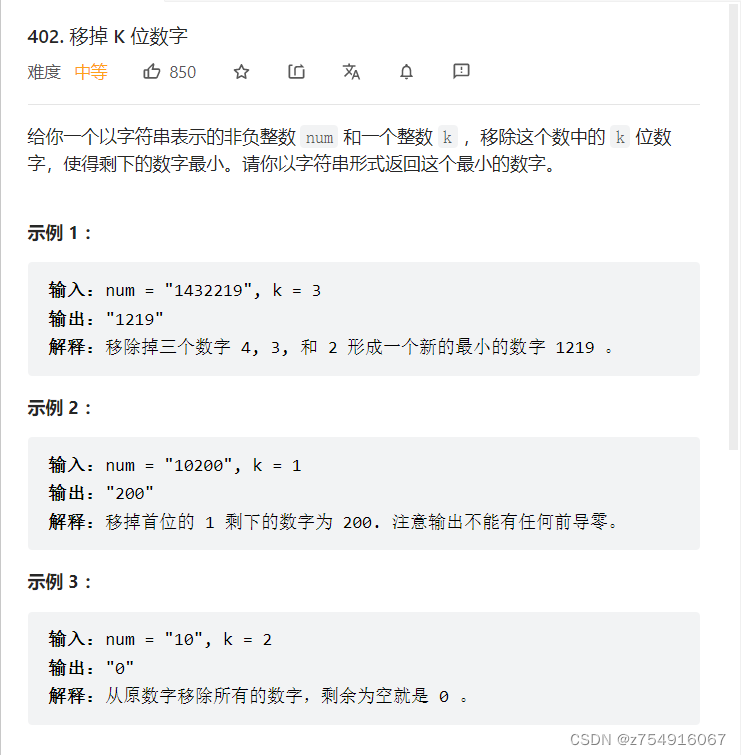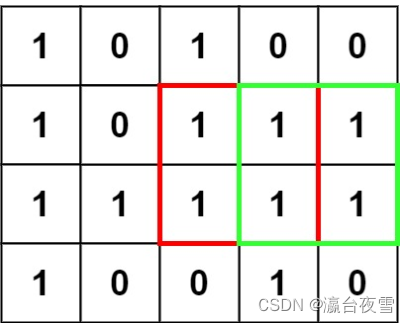当前位置:网站首页>Extended Chinese Remainder Theorem
Extended Chinese Remainder Theorem
2022-08-10 22:04:00 【aWty_】
exCRT
CRT
关于 C R T CRT CRT,The main idea is this,for a system of equations:
{ x ≡ a 1 ( m o d m 1 ) x ≡ a 1 ( m o d m 2 ) ⋮ x ≡ a n ( m o d m n ) \begin{cases} x \equiv a_1 \pmod {m_1} \\ x \equiv a_1 \pmod {m_2} \\ \vdots \\ x \equiv a_n \pmod {m_n} \end{cases} ⎩⎨⎧x≡a1(modm1)x≡a1(modm2)⋮x≡an(modmn)
Let's say we make:
m = ∏ i = 1 n m i , M i = m m i m = \prod_{i = 1}^n m_i, M_i = \frac m {m_i} m=i=1∏nmi,Mi=mim
然后求出 M i M_i Mi 在模 m i m_i mi 意义下的乘法逆元 t i t_i ti,So we got the answer:
a n s = ∑ i = 1 n a i M i t i ans = \sum_{i = 1}^n a_i M_i t_i ans=i=1∑naiMiti
in the calculation step here,Obviously, when calculating the inverse element, it requires gcd ( M i , m i ) = 1 \gcd(M_i, m_i) = 1 gcd(Mi,mi)=1,then the requirement { m i } \{ m_i \} { mi} l两两互质.
exCRT
总体思路
Extending the Chinese remainder theorem is to solve m i m_i mi Methods of Solving Equations When Pairs Are Not Coprime.
But we can find out after a little thought,要想在 C R T CRT CRT On the basis of small changes to achieve e x C R T exCRT exCRT impossible,因为如果 gcd ( M i , m i ) ≠ 1 \gcd(M_i, m_i) \neq 1 gcd(Mi,mi)=1 If so, then the inverse element does not even exist.,So we need to jump out C R T CRT CRT framework to think about how to scale.
We consider combining the two equations,if it can be merged quickly,So we only need to continue to be merged to directly solve the rest,The only one,简单的,显然的,The linear congruence equation will solve the problem.
合并
Consider the merger of two equations:
{ x ≡ a 1 ( m o d m 1 ) x ≡ a 2 ( m o d m 2 ) \begin{cases} x \equiv a_1 \pmod {m_1} \\ x \equiv a_2 \pmod {m_2} \end{cases} { x≡a1(modm1)x≡a2(modm2)
So we can get according to the nature of the congruence:
x = k 1 m 1 + a 1 = k 2 m 2 + a 2 x = k_1m_1 + a_1 = k_2 m_2 + a_2 x=k1m1+a1=k2m2+a2
移一下项:
k 1 m 1 − k 2 m 2 = a 2 − a 1 k_1m_1 - k_2m_2 = a_2 - a_1 k1m1−k2m2=a2−a1
The form of this formula may not be so intuitive,所以我们令 a = m 1 , b = m 2 , c = a 2 − a 1 , x = k 1 , y = − k 2 a = m_1, b = m_2, c = a_2 - a_1, x = k_1, y = -k_2 a=m1,b=m2,c=a2−a1,x=k1,y=−k2,Did this formula suddenly become like this?:
a x + b y = c ax + by = c ax+by=c
This is a classical indefinite equation solving problem.,Then according to Pei Shu's theorem,我们就能知道:
- 如果 gcd ( m 1 , m 2 ) ∣ ( r 2 − r 1 ) \gcd(m_1, m_2) \mid (r_2 - r_1) gcd(m1,m2)∣(r2−r1),Then the equation can be directly used e x g c d exgcd exgcd find a set of special solutions for her
- 否则,方程无解
那么我们求出 x = k 1 m 1 + a 1 x = k_1m_1 + a_1 x=k1m1+a1 之后就得到了一个 x x x The special solution at the same time satisfy the two equations.We give this special solution a new variable name X X X.
So we can happy new equations:
x ≡ X ( m o d l c m ( m 1 , m 2 ) ) x \equiv X \pmod {lcm(m_1, m_2)} x≡X(modlcm(m1,m2))
This construction should be very obvious,因为 x x x 与 X X X 模 m 1 m_1 m1 Congruence and x x x 与 X X X 模 m 2 m_2 m2 同余,那么 x x x 与 X X X 模 l c m ( m 1 , m 2 ) lcm(m_1, m_2) lcm(m1,m2) 同余.
算法流程总结
- Take two out of all equations
- 合并(If you can't merge output without a solution)
- There is only one equation left, directly solve the only one equation to get the answer
完结撒花!!!
代码
#include<bits/stdc++.h>
using namespace std;
#define int __int128
#define in read()
#define MAXN 100100
inline int read(){
int x = 0; char c = getchar();
while(c < '0' or c > '9') c = getchar();
while('0' <= c and c <= '9'){
x = x * 10 + c - '0'; c = getchar();
}
return x;
}
void write(int x){
if(x < 0) putchar('-'), x = -x;
if(x > 9) write(x / 10);
putchar(x % 10 + '0');
}
int n = 0;
int a[MAXN] = {
0 };
int m[MAXN] = {
0 };
int k1 = 0, k2 = 0;
int exgcd(int a, int b, int &x, int &y){
if(!b) {
x = 1, y = 0; return a; }
int d = exgcd(b, a % b, x, y);
int z = x; x = y, y = z - y * (a / b);
return d;
}
signed main(){
n = in; int ans = 0, lcm = 0;
for(int i = 1; i <= n; i++) m[i] = in, a[i] = in;
for(int i = 1; i < n; i++){
k1 = 0, k2 = 0;
int d = exgcd(m[i], m[i + 1], k1, k2);
if((a[i + 1] - a[i]) % d != 0) {
puts("-1"); return 0; }
lcm = m[i] / d * m[i + 1];
a[i + 1] = k1 * (a[i + 1] - a[i]) / d * m[i] + a[i];
a[i + 1] = (a[i + 1] % lcm + lcm) % lcm; m[i + 1] = lcm;
}
int y = 0;
exgcd(1, m[n], ans, y);
write((ans * a[n] + m[n]) % m[n]);
return 0;
}
边栏推荐
- Bedtime story | made a Bitmap and AST length system configuration
- C. Rotation Matching
- 华为路由器旁挂引流实验(使用流策略)
- The use of TortoiseSVN little turtle
- INSERT:插入操作语法&使用例——《mysql 从入门到内卷再到入土》
- ACM模板笔记:最长不下降/上升子序列
- Kubernetes Notes / Getting Started / Production Environment / Installing Kubernetes with Deployment Tools / Starting a Cluster with kubeadm / Creating a Cluster with kubeadm
- Live Classroom System 08 Supplement - Tencent Cloud Object Storage and Course Classification Management
- About DataFrame: Processing Time
- An article to teach you a quick start and basic explanation of Pytest, be sure to read
猜你喜欢

Common interview questions for APP UI automation testing, maybe useful~

LeetCode-498 - Diagonal Traversal

LeetCode-36-Binary search tree and doubly linked list

APP UI自动化测试常见面试题,或许有用呢~

石油化工行业商业供应链管理系统:标准化供应商管理,优化企业供应链采购流程

LeetCode-402 - Remove K digits

Likou 221 questions, the largest square

C#【必备技能篇】Hex文件转bin文件的代码实现

HighTec快捷键(Keys)设置位置

What are the concepts, purposes, processes, and testing methods of interface testing?
随机推荐
LeetCode-36-二叉搜索树与双向链表
Object.assign用法 以及 与$.extend的区别
异常的了解
shell编程之正则表达式与文本处理器
SELECT:简单的查询操作语法&使用例——《mysql 从入门到内卷再到入土》
Live Classroom System 08 Supplement - Tencent Cloud Object Storage and Course Classification Management
FPGA - 7系列 FPGA内部结构之Memory Resources -03- 内置纠错功能
LeetCode-498-对角线遍历
变量和它的特性——《mysql 从入门到内卷再到入土》
The perfect alternative to domestic Gravatar avatars Cravatar
2022.8.9 Mock Competition
Shell 编程--Sed
shell脚本
In 2021 China industrial Internet security competition (competition) in fujian province and the first industry of fujian province Internet innovation competition
labelme - block drag and drop events
shell (text printing tool awk)
测试4年感觉和1、2年时没什么不同?这和应届生有什么区别?
[Maui official version] Create a cross-platform Maui program, as well as the implementation and demonstration of dependency injection and MVVM two-way binding
服务——DNS正向反向域名解析服务
字节跳动原来这么容易就能进去...